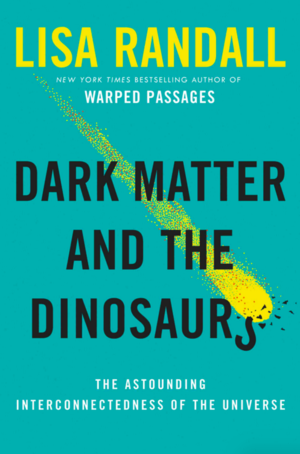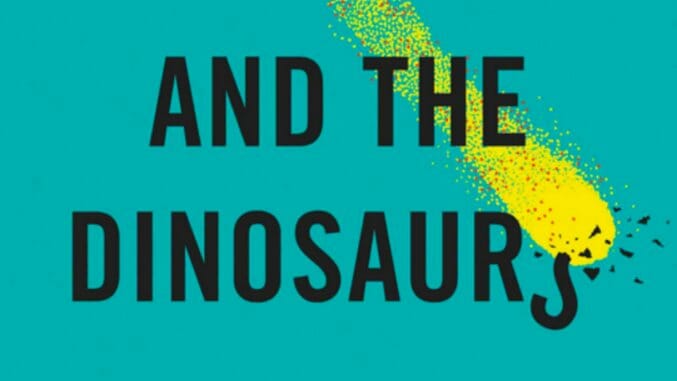Lisa Randall is a Great Spider, in the most generous and pulchritudinous way such an analogue can be extended. She gathers a great many threads—some immediate, sticky, miring us in our day-to-day lives, and others thin, invisible, the incomprehensible ligature of existence—and weaves them into a web encompassing, in this particular instance, nothing less than the entirety of the Universe. She then shares this entirety with academic grace in the telescopic Dark Matter and the Dinosaurs: The Astounding Interconnectedness of the Universe.
 Randall and her colleagues posit that a hypothetical, comparatively thin disk of dark matter lays along with the central disk of the Milky Way and other galaxies. And this disk may be responsible for the periodic dislodging of impactors from their holding patterns in the icy and expansive Oort cloud, the miasmic region of comets that encircles our galaxy. One such dislodged impactor is argued to be the object that exterminated, among a host of other things, the dinosaurs. This disk acceptably fills in a number of gaps in the scientific understanding of the universe, and, if real, could also be our best hope for definitively observing the ever elusive, yet maddeningly proliferate, dark matter.
Randall and her colleagues posit that a hypothetical, comparatively thin disk of dark matter lays along with the central disk of the Milky Way and other galaxies. And this disk may be responsible for the periodic dislodging of impactors from their holding patterns in the icy and expansive Oort cloud, the miasmic region of comets that encircles our galaxy. One such dislodged impactor is argued to be the object that exterminated, among a host of other things, the dinosaurs. This disk acceptably fills in a number of gaps in the scientific understanding of the universe, and, if real, could also be our best hope for definitively observing the ever elusive, yet maddeningly proliferate, dark matter.
Dark matter is the invisible-in-every-sense form of matter that comprises great swaths of the Universe, and we know it must exist by (stay with us!)…our own existence. Based on our understandings of the Standard Model of physics and matter—the stuff everything we can see is made out of—the forces are too weak and the universe too young for the vast array of massive features currently covering empyrean. The roughly 13.8 billion years that have passed since the Big Bang are simply not long enough to account for such godly structures. The answer to this is a form of matter undetectable to us that accounts for the hidden mass necessary for galactic formations: dark matter.
Randall, et. al.’s theory of a type of dark matter capable of interacting with itself—she is hinging this upon the relatively (ha!) simple idea that since all standard matter does not react the same, why should all dark matter be homogenous in composition and activity?—is still unproven, although it may well be settled fairly soon. Veracity aside, it also serves, as the book’s subtitle says, to demonstrate the remarkable interconnectedness of the Universe.
This is the single most beneficial aspect of the book for the casual reader. By grounding one in the principles of cosmology, particle physics, geology, astrophysics, paleontology and meteoritics, Randall provides the reader with a broad spectrum look at not only the world around them, but the worlds around that world, the galaxies and galactic clusters, filaments, sheets and, eventually, the Universe.
Dark matter aids in begetting standard matter objects—galaxies, stars, planets, etc.—that in turn eventually develop life. Dark matter (hypothetically) aids in diverting an impactor into the Solar System, wiping said life from the face of the Earth. Everything is related, bearing out upon one another in ways we are only beginning to comprehend. The thought is dizzying, inspiring feelings as far afield as deific mastery and terrible, shrieking fear at the immensity of it all. The arousal of vast, paradoxical emotions should be considered a mark of good science.
How does Randall accomplish this? First, the classic dominance of scale. Dark Matter and the Dinosaurs encompasses things so small they could rightly be called nothing and the absolute largest expanses, voids, abysses, like seriously fucking everything. To be presented with such is to be battledored between the elasticity—and relative transparency—of her revelations both intoxicating and inspirational. This is directly related to the second success of both the book and Randall’s career; namely, her ability to convey science cleanly, efficiently and magnanimously. Her content only rarely wanders off into semi-inextricable thickets and avoids—and these are the far greater sins—the utter abandonment of her charges to the mind-warping density of true physics discourse and the kind of hand holding which leads one to feeling like a particularly dull child or dog.
Scientists, after all, accept a position outside of most authors—many nonfiction writers excluded—in that we trust them to bring us through their subject not only intact but better off. In walking readers through dark matter, meteoritics and cosmology 101, Randall proves the true power and potential of her and her colleagues’ theory that it may help us to not only understand our past and present, but all time, all things.
When Dark Matter and the Dinosaurs is clicking, when the connections are sparking as if synapses are firing on the page, the true power of physics takes hold.
B. David Zarley is a freelance journalist, essayist and book/music/art critic currently based in Chicago. A former book critic for The Myrtle Beach Sun News, his work can be seen in VICE, VICE Sports, Sports on Earth, The Classical and New American Paintings, among numerous other publications. You can find him on Twitter or at his website.

 Randall and her colleagues posit that a hypothetical, comparatively thin disk of dark matter lays along with the central disk of the Milky Way and other galaxies. And this disk may be responsible for the periodic dislodging of impactors from their holding patterns in the icy and expansive Oort cloud, the miasmic region of comets that encircles our galaxy. One such dislodged impactor is argued to be the object that exterminated, among a host of other things, the dinosaurs. This disk acceptably fills in a number of gaps in the scientific understanding of the universe, and, if real, could also be our best hope for definitively observing the ever elusive, yet maddeningly proliferate, dark matter.
Randall and her colleagues posit that a hypothetical, comparatively thin disk of dark matter lays along with the central disk of the Milky Way and other galaxies. And this disk may be responsible for the periodic dislodging of impactors from their holding patterns in the icy and expansive Oort cloud, the miasmic region of comets that encircles our galaxy. One such dislodged impactor is argued to be the object that exterminated, among a host of other things, the dinosaurs. This disk acceptably fills in a number of gaps in the scientific understanding of the universe, and, if real, could also be our best hope for definitively observing the ever elusive, yet maddeningly proliferate, dark matter.